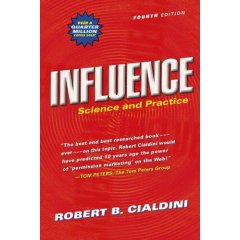
I recently received an Amazon order I’d been looking forward to for some time, and thought I’d share with you my thoughts on one of the two books I’d ordered (and which I’ve just finished reading): Influence: Science and Practice (International Edition) by Robert B. Cialdini, which I’d first heard of when Scott Adams mentioned it.
It’s a remarkably deep and thought-provoking book which I thoroughly enjoyed. It sets out to be valuable as a course text (barely a paragraph goes by without making reference to some study or paper), but succeeds also in appealing to the “living room psychologist” in us all, too. Its informal tone makes it immensely pick-up-and-readable, and it covers all of it’s concepts from the ground up in a witty, friendly style.
The book is about the various means of influence – that is, persuasion, coercion, and control – that can be exerted over people through the subtle use of various techniques. The studies referenced by the author are wide-ranging, and the subjects ubiquitous, and you’ll end up nodding in agreement as you read about tricks of the trade you’ve seen used by advertisers, tele-salespeople, shopkeepers, preachers… even lawyers and politicians. It’s all approachable as pop psychology, but equally it’s backed by hundreds of well-referenced, well-researched studies from the 1940s to the present day.
Did you know that, statistically speaking, when somebody crosses the street in a place where it is illegal to do so, about three times as many people will follow them across, on average, if they are wearing a suit? That in some markets and at certain times, putting prices up will increase sales dramatically? That during the week after a widely-reported news story about a high-profile suicide, the number of people killed in commercial aeroplane crashes averages triple what it does in the previous week? These are the kinds of phenomena that Cialdini investigates, using sackloads of evidence from dozens of studies for each, and applies meaningful and believable theories to. The book’s broken up into chapters each discussing a different “weapon of influence,” and they’re all fascinating, well-researched, and engaging. It fells a little America-centric from time to time, and the ending feels abrupt (a result of the last two chapters being significantly shorter than most of the others), but it’s still a great read.
If you’re selling anything, or if you find it hard to say no to surveyors and salespeople, or if you’re just interested in the elements of social persuasion, I’d recommend the book. As usual, it’ll be lying around on our coffee table for anybody who’s sat around at The Cottage.